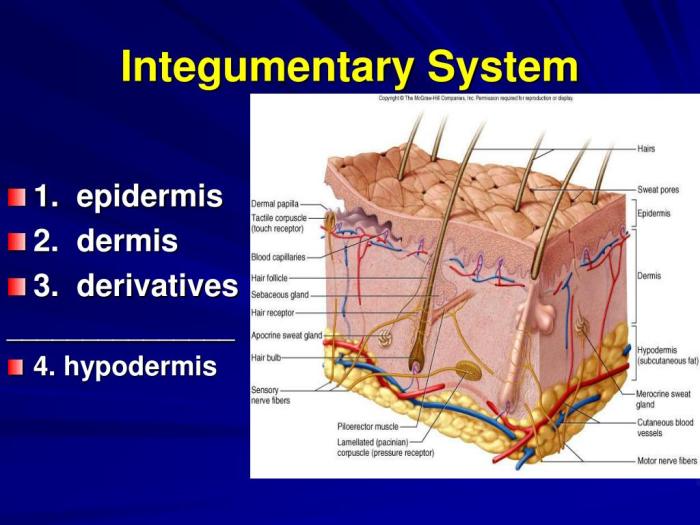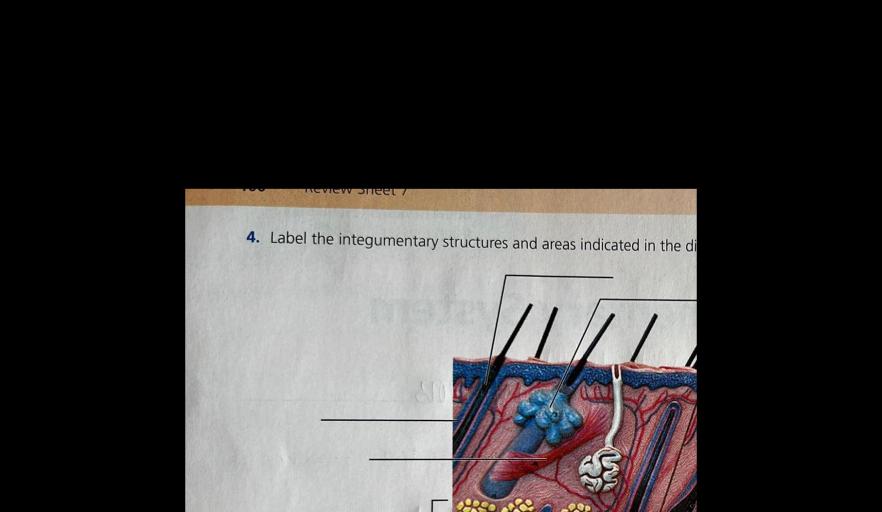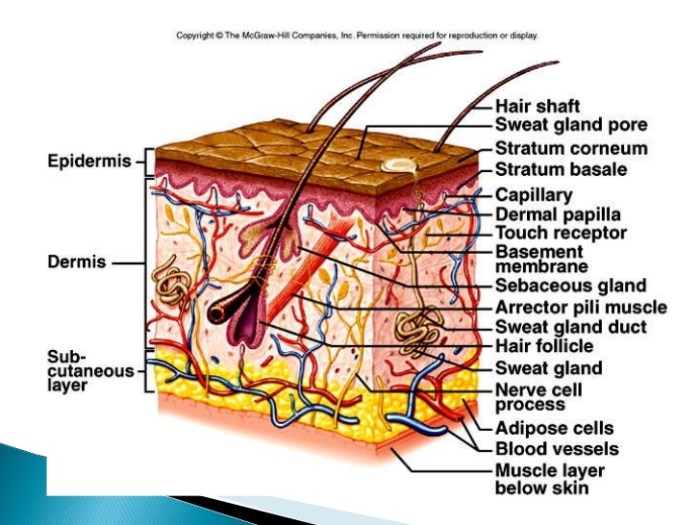Label the integumentary structures and areas: an exploration of the intricate tapestry that safeguards and adorns the human body. Delve into the layers of skin, unravel the mysteries of skin appendages, and discover the remarkable adaptations that enable the integumentary system to thrive in diverse environments.
The skin, the largest organ of the human body, serves as a resilient barrier against external threats, regulates temperature, facilitates sensation, and synthesizes essential vitamins. Skin appendages, including hair, nails, and glands, play crucial roles in protection, thermoregulation, and communication.
Integumentary System Overview

The integumentary system is the outermost layer of the body, composed of the skin, hair, nails, and glands. It serves several essential functions, including:
- Protection from external factors, such as microorganisms, chemicals, and physical trauma
- Regulation of body temperature
- Sensory reception and perception
- Vitamin D synthesis
- Communication through body language and appearance
The major components of the integumentary system include:
- Skin: The largest organ of the body, consisting of multiple layers
- Hair: Keratinized filaments that grow from hair follicles
- Nails: Hard, protective coverings at the tips of fingers and toes
- Glands: Structures that secrete substances onto the skin’s surface
Skin Structure and Functions
The skin is composed of three main layers:
- Epidermis:The outermost layer, consisting of keratinized cells that protect against external factors
- Dermis:The middle layer, containing connective tissue, blood vessels, and nerve endings
- Hypodermis:The innermost layer, composed of fat cells that provide insulation and cushioning
The skin plays a crucial role in protecting the body from:
- Mechanical damage:Abrasions, cuts, and bruises
- Chemical damage:Acids, bases, and solvents
- Radiation:Ultraviolet (UV) rays from the sun
- Microorganisms:Bacteria, viruses, and fungi
Additionally, the skin:
- Regulates body temperature:Through sweating and dilation or constriction of blood vessels
- Perceives sensations:Touch, pressure, pain, and temperature
- Synthesizes vitamin D:When exposed to UV rays
Skin Appendages

The skin has several appendages that serve various functions:
Hair
- Protects the scalp from UV radiation and cold temperatures
- Insulates the body
- Helps remove sweat from the skin’s surface
Nails
- Protect the fingertips and toes from injury
- Assist in grasping and manipulating objects
Glands
- Sweat glands:Produce sweat to regulate body temperature and excrete waste products
- Sebaceous glands:Secrete sebum, which lubricates the skin and hair
- Apocrine glands:Produce a milky secretion that contributes to body odor
- Mammary glands:Secrete milk to nourish infants
Integumentary System Disorders
The integumentary system is susceptible to various disorders, including:
Acne
- A common skin condition caused by inflammation of hair follicles
- Characterized by blackheads, whiteheads, and pimples
Psoriasis
- A chronic autoimmune disorder that causes red, scaly patches on the skin
- Symptoms can range from mild to severe
Skin cancer, Label the integumentary structures and areas
- A malignant growth of skin cells
- Can be caused by excessive exposure to UV radiation
Integumentary System Care

Proper skin care is essential for maintaining healthy skin. It includes:
- Cleansing:Removing dirt, oil, and makeup from the skin
- Moisturizing:Applying lotions or creams to hydrate the skin and prevent dryness
- Sun protection:Using sunscreen to protect the skin from UV radiation
Following these practices can help prevent skin disorders, maintain a youthful appearance, and promote overall skin health.
Integumentary System in Different Animals: Label The Integumentary Structures And Areas

The integumentary system varies across different animal species, adapting to their unique environments and lifestyles:
Mammals
- Have hair or fur for insulation and protection
- Sweat glands help regulate body temperature
Reptiles
- Have scales for protection and waterproofing
- Some reptiles shed their skin periodically
Birds
- Have feathers for insulation and flight
- Feathers also provide camouflage and display functions
FAQ Corner
What is the primary function of the integumentary system?
Protection, thermoregulation, sensation, and vitamin D synthesis.
Name the three layers of the skin.
Epidermis, dermis, hypodermis.
What is the function of hair?
Protection, insulation, and sensory reception.